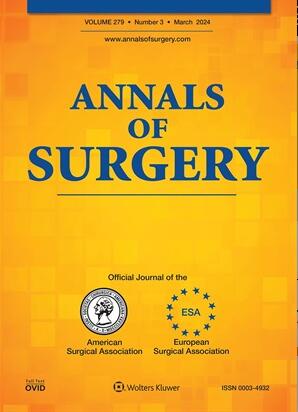烧伤后幸存者和非幸存者的轨迹。
IF 6.4
1区 医学
Q1 SURGERY
引用次数: 0
摘要
为了深入了解烧伤后的全身反应,我们旨在描述幸存者和非幸存者的炎症和代谢轨迹的阶段。背景:在过去的几十年里,烧伤后的存活率有所提高。然而,很大一部分患者没有存活下来。方法本研究为单中心队列研究。我们纳入了年龄≥18岁的烧伤患者(≥体表面积的10%;被我们省烧伤中心收治。比较幸存者、早期非幸存者(损伤后死亡≤4天)和晚期非幸存者(损伤后死亡≥5天)的临床结果、实验室测量和炎症生物标志物。结果我们研究了872例患者,中位年龄为49岁(四分位间距,IQR: 35-63),幸存者中位TBSA烧伤百分比为19% (IQR: 13-34) (n=705;81%),早期非幸存者(n=99;11%)和晚期非幸存者(n=68;8%)。幸存者的中位年龄为46岁(IQR: 33-59),早期非幸存者为62岁(IQR: 46-73),晚期非幸存者为67岁(IQR: 54-76) (P<0.0001)。幸存者TBSA烧伤的中位数%为17 (IQR: 13-26),早期非幸存者为67 (IQR: 43-88),晚期非幸存者为27 (IQR: 18-44) (P<0.0001)。与幸存者相比,非幸存者表现出显著升高的生物标志物,具有不同的代谢和炎症特征,包括增加的IL-1β, IL-8, TNF-α和IL-10。晚期非幸存者的并发症发生率更高(P<0.01),随着时间的推移,炎症和代谢反应有显著差异。结论幸存者和非幸存者表现出明显的损伤后炎症和代谢反应。确定幸存者和非幸存者之间伴随的免疫激活和抑制之间的关系可以通过定义和改变炎症轨迹来改善患者的预后。阐明早期和晚期非幸存者之间的轨迹差异可以预测和识别有死亡风险的患者。本文章由计算机程序翻译,如有差异,请以英文原文为准。
Trajectories of Survivors and Non-Survivors Post-burn Injury.
OBJECTIVE
To gain insights into the systemic response after burn injury, we aimed to characterize the phases of inflammatory and metabolic trajectories in survivors and non-survivors.
BACKGROUND
Survival after burn injuries has improved over the past few decades. However, a large proportion of the patients do not survive.
METHODS
This was a single-center cohort study. We included patients (aged ≥ 18 years) with burn injuries (≥ 10% total body surface area; TBSA) admitted to our provincial burn center. Clinical outcomes, laboratory measures, and inflammatory biomarkers were compared among survivors, early non-survivors (died ≤4 days post-injury), and late non-survivors (died ≥5 days post-injury).
RESULTS
We studied 872 patients with a median age of 49 (Interquartile Range, IQR: 35-63) years and a median percent TBSA burn of 19% (IQR: 13-34) TBSA burn for survivors (n=705; 81%), early non-survivors (n=99; 11%), and late non-survivors (n=68; 8%). The median ages were 46 (IQR: 33-59) years for survivors, 62 (IQR: 46-73) years for early non-survivors, and 67 (IQR: 54-76) years for late non-survivors (P<0.0001). The median % TBSA burn was 17 (IQR: 13-26) for survivors, 67 (IQR: 43-88) for early non-survivors, and 27 (IQR: 18-44) for late non-survivors (P<0.0001). Non-survivors exhibited significantly elevated biomarkers compared to survivors, with distinct metabolic and inflammatory profiles, including increased IL-1β, IL-8, TNF-α, and IL-10. Late non-survivors experienced higher complication rates (P<0.01), with significant differences in inflammatory and metabolic responses over time.
CONCLUSIONS
Survivors and non-survivors showed distinct post-injury inflammatory and metabolic responses. Identifying the relationship between concomitant immune activation and suppression among survivors and non-survivors may improve patient outcomes by defining and altering inflammatory trajectories. Elucidating the differences in trajectories between early and late non-survivors could allow for the prediction and identification of patients at risk of mortality.
求助全文
通过发布文献求助,成功后即可免费获取论文全文。
去求助
来源期刊

Annals of surgery
医学-外科
CiteScore
14.40
自引率
4.40%
发文量
687
审稿时长
4 months
期刊介绍:
The Annals of Surgery is a renowned surgery journal, recognized globally for its extensive scholarly references. It serves as a valuable resource for the international medical community by disseminating knowledge regarding important developments in surgical science and practice. Surgeons regularly turn to the Annals of Surgery to stay updated on innovative practices and techniques. The journal also offers special editorial features such as "Advances in Surgical Technique," offering timely coverage of ongoing clinical issues. Additionally, the journal publishes monthly review articles that address the latest concerns in surgical practice.
 求助内容:
求助内容: 应助结果提醒方式:
应助结果提醒方式:


